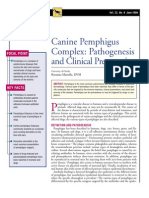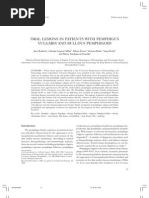Immunologic Mechanism of Pathogenic Autoantibody Production in Pemphigus
Immunologic Mechanism of Pathogenic Autoantibody Production in Pemphigus
Uploaded by
Cristian QuitoCopyright:
Available Formats
Immunologic Mechanism of Pathogenic Autoantibody Production in Pemphigus
Immunologic Mechanism of Pathogenic Autoantibody Production in Pemphigus
Uploaded by
Cristian QuitoOriginal Title
Copyright
Available Formats
Share this document
Did you find this document useful?
Is this content inappropriate?
Copyright:
Available Formats
Immunologic Mechanism of Pathogenic Autoantibody Production in Pemphigus
Immunologic Mechanism of Pathogenic Autoantibody Production in Pemphigus
Uploaded by
Cristian QuitoCopyright:
Available Formats
CHAPTER
Immunologic Mechanism of Pathogenic
29
Fig. 29.5 Pemphigus
vulgaris – oral
Autoantibody Production in Pemphigus involvement. Essentially
Pemphigus
In contrast to the significant progress since the late 1980s in under- all patients develop
standing the pathophysiologic mechanisms of blister formation in pem- painful oral mucosal
phigus, it is still unclear why patients with pemphigus begin to produce erosions. The most
common sites are the
the pathogenic autoantibodies. buccal (A) and palatine
Pemphigus autoantibodies are composed of IgG isotypes, which may mucosae, but lesions can
be produced after isotype switching, and they have a high affinity also develop on the
towards the antigen, which may be a result of affinity maturation of gingivae (B) and tongue
the antibodies. In addition, pemphigus sera recognize several distinct (C). A, Courtesy, Lorenzo Cerroni,
epitopes on desmogleins31, and the presence of autoantibodies is associ- MD; B,C, Courtesy, Jeffrey P Callen,
ated with specific HLA class II alleles, including DRB1*0402, MD.
A
DRB1*1401 and DQB1*0302 in Caucasians39 and DRB1*14 and
DQB1*0503 in Japanese40. All of these features suggest that autoanti-
body production in pemphigus is T cell-dependent. More recently, T
cells reactive against Dsg3 were shown to be present in peripheral blood
from patients with pemphigus vulgaris as well as healthy individuals41–43.
Certain peptides from Dsg3, predicted to fit into the DRB1*0402
pocket, were able to stimulate T cells from the pemphigus patients.
Another advance that will allow the study of T cells and B cells is
the development of an active disease mouse model for pemphigus vul-
garis44. This model is valuable not only for dissecting the cellular and
molecular mechanisms involved in antibody production but also for
developing novel therapeutic strategies.
B
CLINICAL FEATURES
Pemphigus Vulgaris
Essentially all patients with pemphigus vulgaris develop painful ero-
sions of the oral mucosa. More than half of the patients also develop
flaccid blisters and widespread cutaneous erosions. Pemphigus vulgaris
is therefore divided into two subgroups: (1) the mucosal-dominant type
with mucosal erosions but minimal skin involvement; and (2) the
mucocutaneous type with extensive skin blisters and erosions in addi-
tion to mucosal involvement (see Fig. 29.4).
Mucous membrane lesions usually present as painful erosions
(Fig. 29.5). Intact blisters are rare, probably because they are fragile
and break easily. Although scattered or extensive erosions may be C
seen anywhere in the oral cavity, the most common sites are the
buccal and palatine mucosa. The erosions are of different sizes
with an irregular and ill-defined border, which, when extensive or
painful, may result in decreased oral intake of food or liquids. The
diagnosis of pemphigus vulgaris tends to be delayed in patients pre-
UNUSUAL CLINICAL PRESENTATIONS OF PEMPHIGUS VULGARIS
senting with only oral involvement, as compared to patients with
skin lesions. Isolated crusted plaque on face or scalp
The lesions may extend out onto the vermilion lip and lead to thick, Paronychia and/or onychomadesis
fissured hemorrhagic crusts. Involvement of the throat produces hoarse- Foot ulcers
ness and difficulty in swallowing. The esophagus also may be involved Dyshidrotic eczema or pompholyx
and sloughing of its entire lining in the form of a cast has been reported. Macroglossia
The conjunctivae, nasal mucosa, vagina, labia, penis and anus can
Table 29.3 Unusual clinical presentations of pemphigus vulgaris.
develop lesions as well. Cytology of vaginal cells may be misread as a
malignancy when vaginal lesions are present.
The primary skin lesions of pemphigus vulgaris are flaccid, thin-
walled, easily ruptured blisters (Fig. 29.6). They can appear anywhere
on the skin surface and arise on either normal-appearing skin or erythe-
treatment, pemphigus vulgaris can be fatal because a large portion of
matous bases. The fluid within the bullae is initially clear but may
the skin loses its epidermal barrier function, leading to the loss of body
become hemorrhagic, turbid, or even seropurulent. The blisters are
fluids or to secondary bacterial infections.
fragile and soon rupture to form painful erosions that ooze and bleed
easily. These erosions often attain a large size and can become general-
ized. The erosions soon become partially covered with crusts that have Pemphigus Vegetans
little or no tendency to heal. Those lesions that do heal often leave Pemphigus vegetans is a rare vegetative variant of pemphigus vulgaris,
hyperpigmented patches with no scarring. Associated pruritus is and it is thought to represent a reactive pattern of the skin to the
uncommon. Table 29.3 outlines more unusual clinical presentations of autoimmune insult of pemphigus vulgaris.
pemphigus vulgaris. Pemphigus vegetans is characterized by flaccid blisters that become
Because of an absence of cohesion within the epidermis, its upper erosions and then form fungoid vegetations or papillomatous prolifera-
layers easily move laterally with slight pressure or rubbing in patients tions, especially in intertriginous areas and on the scalp or face (Fig.
with active disease (Nikolsky sign). The lack of cohesion of the skin 29.7). Pustules rather than vesicles characterize early lesions, but these
may also be demonstrated with the “bulla-spread phenomenon” – soon progress to vegetative plaques. The tongue may show cerebriform-
gentle pressure on an intact bulla forces the fluid to spread under the like changes. Two subtypes are recognized: the severe Neumann type
skin away from the site of pressure (Asboe–Hansen sign, also referred and the mild Hallopeau type. Occasionally, a vegetative response may 499
to as the “indirect Nikolsky” or “Nikolsky II” sign). Without appropriate also be seen in lesions of pemphigus vulgaris that tend to be resistant
You might also like
- MediCall Past Papers PDFDocument1,224 pagesMediCall Past Papers PDFarsalan67% (3)
- Rabies Vaccination CertificateDocument1 pageRabies Vaccination CertificatevindingNo ratings yet
- STEP 1 CluesDocument3 pagesSTEP 1 CluesRaji NaamaniNo ratings yet
- Autoimmune Vesiculobullous LesionsDocument32 pagesAutoimmune Vesiculobullous LesionsPrathusha UmakhanthNo ratings yet
- 3 - Vesiculobullous Skin Diseases (Document48 pages3 - Vesiculobullous Skin Diseases (kylekylecrocodile7No ratings yet
- Herpetiform Pemphigus: Courtesy, Ronald P Rapini, MDDocument1 pageHerpetiform Pemphigus: Courtesy, Ronald P Rapini, MDCristian QuitoNo ratings yet
- Bullous Disease: Farah Alsheikh Dima ArabiyatDocument58 pagesBullous Disease: Farah Alsheikh Dima ArabiyatAhmad AltarefeNo ratings yet
- 1659 PDFDocument5 pages1659 PDFSiti HanisaNo ratings yet
- Autoimmune Bullous DiseaseDocument10 pagesAutoimmune Bullous DiseaseSiti Habibah ZeinNo ratings yet
- Pénfigo y PenfigoideDocument12 pagesPénfigo y PenfigoideRenato Poblete HormazabalNo ratings yet
- Seminars in Diagnostic Pathology: Bullous, Pseudobullous, & Pustular DermatosesDocument11 pagesSeminars in Diagnostic Pathology: Bullous, Pseudobullous, & Pustular DermatosesCynthia OktariszaNo ratings yet
- Case Report: Journal of Chitwan Medical College 2020 10 (31) :91-93Document3 pagesCase Report: Journal of Chitwan Medical College 2020 10 (31) :91-93Yeni PuspitasariNo ratings yet
- Bullous skin diseasesDocument47 pagesBullous skin diseasessamy.abusenblNo ratings yet
- PemphigusDocument32 pagesPemphigusAlondra CastilloNo ratings yet
- Pemphigus Vulgaris 1Document3 pagesPemphigus Vulgaris 1Yeni PuspitasariNo ratings yet
- PV 1Document4 pagesPV 1Aing ScribdNo ratings yet
- Seminars in Diagnostic Pathology: Mark R. WickDocument11 pagesSeminars in Diagnostic Pathology: Mark R. WickAbdillah AkbarNo ratings yet
- PemphigusDocument8 pagesPemphiguszuqiri ChanelNo ratings yet
- 20 Lecture Oral Mucosa Vesiculo-Bullous DiseaseDocument10 pages20 Lecture Oral Mucosa Vesiculo-Bullous Diseaseمازن كريم حمودNo ratings yet
- 20 Lecture Oral Mucosa Vesiculo-Bullous DiseaseDocument10 pages20 Lecture Oral Mucosa Vesiculo-Bullous Diseaseمازن كريم حمودNo ratings yet
- Enfermedades InmunologicasDocument14 pagesEnfermedades InmunologicasKarina OjedaNo ratings yet
- Pemphigus Vulgaris: Keywords: Autoimmune Disease, Bullae, Mucous Membrane, Pemphigus VulgarisDocument4 pagesPemphigus Vulgaris: Keywords: Autoimmune Disease, Bullae, Mucous Membrane, Pemphigus VulgarisDwiKamaswariNo ratings yet
- Vesiculobullous DiseasesDocument40 pagesVesiculobullous Diseasessgoeldoc_550661200100% (1)
- 3 - Iabcr 20162 03 02 - 13 17Document6 pages3 - Iabcr 20162 03 02 - 13 17EMNo ratings yet
- Oral Manifestations of Autoinflammatory and Autoimmune DiseasesDocument8 pagesOral Manifestations of Autoinflammatory and Autoimmune DiseasesnaeshaNo ratings yet
- Vesiculobullous DiseasesDocument41 pagesVesiculobullous DiseasesJenniferNo ratings yet
- Refen 3 PDFDocument8 pagesRefen 3 PDFSiti Aulia Rahma SyamNo ratings yet
- Pemphigus: Box IDocument1 pagePemphigus: Box IAsaid HezamNo ratings yet
- Pemphigus Vulgaris: Keywords: Autoimmune Disease, Bullae, Mucous Membrane, Pemphigus VulgarisDocument4 pagesPemphigus Vulgaris: Keywords: Autoimmune Disease, Bullae, Mucous Membrane, Pemphigus VulgarisSetiari DewiNo ratings yet
- CANINE-Pemphigus Complex-Pathogenesis and Clinical PresentationDocument5 pagesCANINE-Pemphigus Complex-Pathogenesis and Clinical Presentationtaner_soysuren100% (4)
- Immunopathogenesis of Pemphigus Vulgaris: A Brief ReviewDocument3 pagesImmunopathogenesis of Pemphigus Vulgaris: A Brief ReviewAnonymous SPrI0gbTr0No ratings yet
- Case Report A Case Study On Pemphigus Vulgaris: Indian Journal of Pharmacy Practice February 2017Document4 pagesCase Report A Case Study On Pemphigus Vulgaris: Indian Journal of Pharmacy Practice February 2017Anita berliana tabriNo ratings yet
- Darmstadt 1994Document15 pagesDarmstadt 1994rismahNo ratings yet
- 2020 - Pemphigus Vulgaris and Bullous Pemphigoid Update On Diagnosis and TreatmentDocument12 pages2020 - Pemphigus Vulgaris and Bullous Pemphigoid Update On Diagnosis and TreatmentnancyerlenNo ratings yet
- Bullous Diseases (Lec. 12) by Dr. Ula AlkadhiDocument9 pagesBullous Diseases (Lec. 12) by Dr. Ula Alkadhi9czwqxyqjgNo ratings yet
- 02VBL PemphigusDocument48 pages02VBL PemphigusRaniya ZainNo ratings yet
- Iga Pemphigus: Clinics in Dermatology (2011) 29, 437-442Document6 pagesIga Pemphigus: Clinics in Dermatology (2011) 29, 437-442Rafiqa Zulfi UmmiahNo ratings yet
- A Case Study On Pemphigus VulgarisDocument3 pagesA Case Study On Pemphigus VulgarisAdib MuntasirNo ratings yet
- Superficial Skin Infections and The Use of Topical and Systemic Antibiotics in General PracticeDocument4 pagesSuperficial Skin Infections and The Use of Topical and Systemic Antibiotics in General Practicepeter_mrNo ratings yet
- Pemphigus Foliaceus: Fig. 29.13BDocument1 pagePemphigus Foliaceus: Fig. 29.13BCristian QuitoNo ratings yet
- Vesiculobullous DiseasesDocument48 pagesVesiculobullous DiseasesAprilian PratamaNo ratings yet
- Impetigo - Review : Luciana Baptista Pereira1Document7 pagesImpetigo - Review : Luciana Baptista Pereira1Edwar RevnoNo ratings yet
- Tugas Jurnal Blok 12Document7 pagesTugas Jurnal Blok 12Astasia SefiwardaniNo ratings yet
- MV Chap 5Document8 pagesMV Chap 5jacquelinebiteranta13No ratings yet
- Dermatological DiseasesDocument29 pagesDermatological DiseasesAhmed NajmNo ratings yet
- 005 - Additional MaterialDocument22 pages005 - Additional MaterialLucas Victor AlmeidaNo ratings yet
- Bullous Skin Disorder. 6Document90 pagesBullous Skin Disorder. 6Oduntan DanielNo ratings yet
- Oral Lesions in Patients With Pemphigus Vulgaris and Bullous PemphigoidDocument6 pagesOral Lesions in Patients With Pemphigus Vulgaris and Bullous PemphigoidmkoaaoNo ratings yet
- B. Diseases With Subepidermal Blistering (Pemphigoid Group) : 9. Fogo Selvagem, Brazilian Pemphigus FoliaceusDocument7 pagesB. Diseases With Subepidermal Blistering (Pemphigoid Group) : 9. Fogo Selvagem, Brazilian Pemphigus FoliaceusLukman GhozaliNo ratings yet
- Bullous-2018 TPDocument136 pagesBullous-2018 TPMary Dominique RomoNo ratings yet
- Jurnal 3Document12 pagesJurnal 3DwiKamaswariNo ratings yet
- Penfigo por IgADocument6 pagesPenfigo por IgAfrancienepimenta1No ratings yet
- Pemphigus Vulgaris and Mucous Membrane Pemphigoid: Dis-Similarly Similar LesionsDocument9 pagesPemphigus Vulgaris and Mucous Membrane Pemphigoid: Dis-Similarly Similar LesionsarushNo ratings yet
- 3247 PDFDocument6 pages3247 PDFMiftahul JannahNo ratings yet
- Pemphigus: Clinical FeaturesDocument7 pagesPemphigus: Clinical FeaturesjalalfaizNo ratings yet
- 4 U1.0 B978 1 4377 0755 7..00235 9..DOCPDFDocument3 pages4 U1.0 B978 1 4377 0755 7..00235 9..DOCPDFdisk_la_poduNo ratings yet
- DiagnosticDocument21 pagesDiagnosticFRI CHIKSNo ratings yet
- Bacterial InfectionsDocument32 pagesBacterial Infectionsjoddss1No ratings yet
- Intraepidermal Autoimmune Bullous Dermatoses: Principles of DiagnosisDocument31 pagesIntraepidermal Autoimmune Bullous Dermatoses: Principles of DiagnosisCiubuc AndrianNo ratings yet
- immunological ulcersDocument11 pagesimmunological ulcersabdulazizsaleh00000No ratings yet
- Gonorrhea - An Evolving Disease of The New Millennium: ReviewDocument19 pagesGonorrhea - An Evolving Disease of The New Millennium: ReviewValeria Moretto VegaNo ratings yet
- 2020 Cutaneous Protothecosis As An Unusual Complication Following Dermal Filler Injection A Case Report.Document4 pages2020 Cutaneous Protothecosis As An Unusual Complication Following Dermal Filler Injection A Case Report.Dimitris RodriguezNo ratings yet
- Comprehensive Insights into Haemophilus Influenzae: From Biology to Global Health StrategiesFrom EverandComprehensive Insights into Haemophilus Influenzae: From Biology to Global Health StrategiesNo ratings yet
- Visceral Zoster As The Presenting Feature of Disseminated Herpes ZosterDocument4 pagesVisceral Zoster As The Presenting Feature of Disseminated Herpes ZosterCristian QuitoNo ratings yet
- Psoriasis Lesions Are Associated With Specific Types of Emotions. Emotional Profile in PsoriasisDocument6 pagesPsoriasis Lesions Are Associated With Specific Types of Emotions. Emotional Profile in PsoriasisCristian QuitoNo ratings yet
- Neurological and Psychiatric Disorders in Psoriasis 2018Document9 pagesNeurological and Psychiatric Disorders in Psoriasis 2018Cristian QuitoNo ratings yet
- Polymorphic Eruption of Pregnancy: ReviewDocument7 pagesPolymorphic Eruption of Pregnancy: ReviewCristian QuitoNo ratings yet
- A Case-Control Study of Polymorphic Eruption of Pregnancy: A B C B ADocument5 pagesA Case-Control Study of Polymorphic Eruption of Pregnancy: A B C B ACristian QuitoNo ratings yet
- Fig. 29.6 Pemphigus Vulgaris - Cutaneous Involvement. A Flaccid Blisters and An Erosion B, C Multiple Erosions andDocument1 pageFig. 29.6 Pemphigus Vulgaris - Cutaneous Involvement. A Flaccid Blisters and An Erosion B, C Multiple Erosions andCristian QuitoNo ratings yet
- Fig. 29.10 Paraneoplastic Pemphigus. A The CharacteristicDocument1 pageFig. 29.10 Paraneoplastic Pemphigus. A The CharacteristicCristian QuitoNo ratings yet
- JA A D: M CAD ErmatolDocument2 pagesJA A D: M CAD ErmatolCristian QuitoNo ratings yet
- Antifungal Agents: LipopeptidesDocument8 pagesAntifungal Agents: LipopeptidesCristian QuitoNo ratings yet
- Antinuclear Antibodies Marker of Diagnosis and Evolution in Autoimmune DiseasesDocument12 pagesAntinuclear Antibodies Marker of Diagnosis and Evolution in Autoimmune DiseasesFAIZAN KHANNo ratings yet
- MiddleEastAfrJOphthalmol19113-4844325 132723Document9 pagesMiddleEastAfrJOphthalmol19113-4844325 132723Vincent LivandyNo ratings yet
- Ergothioneine Antioxidant FunctionDocument9 pagesErgothioneine Antioxidant FunctionRora11No ratings yet
- Fitzpatrick's Dermatology 9th Edition, 2-Volume SetDocument22 pagesFitzpatrick's Dermatology 9th Edition, 2-Volume Setririen refrina sariNo ratings yet
- Articulo - HACCP and The Management of Healthcare Associated Infections, Lessons To Be Learnt From Other Industries - 2006Document17 pagesArticulo - HACCP and The Management of Healthcare Associated Infections, Lessons To Be Learnt From Other Industries - 2006Freddy VargasNo ratings yet
- Handout On NeoplasiaDocument87 pagesHandout On NeoplasialydNo ratings yet
- Ts SR Zoology Imp QuestionsDocument4 pagesTs SR Zoology Imp Questionssrneet555No ratings yet
- Pfizer Epar Risk Management Plan - enDocument133 pagesPfizer Epar Risk Management Plan - enguimac07No ratings yet
- © Simtipro SRLDocument5 pages© Simtipro SRLCatia CorreaNo ratings yet
- Methicillin-Resistant Staphylococcus Aureus: An Evolutionary, Epidemiologic, and Therapeutic OdysseyDocument12 pagesMethicillin-Resistant Staphylococcus Aureus: An Evolutionary, Epidemiologic, and Therapeutic OdysseyFelicia HalimNo ratings yet
- JMGCB_1069_Immunological+Study+of+Some+Biomarker+in+Celiac+Disease+in+Basrah+ProvinceDocument10 pagesJMGCB_1069_Immunological+Study+of+Some+Biomarker+in+Celiac+Disease+in+Basrah+ProvinceHana AgustinNo ratings yet
- Australian Immunisation Handbook - 9th Edition 2008 (NHMRC)Document413 pagesAustralian Immunisation Handbook - 9th Edition 2008 (NHMRC)wmross1100% (1)
- Imuno QuizDocument5 pagesImuno Quizᖴᗩᗫᓾ ᘜᓏᒪᕲᘍᘉNo ratings yet
- Full Syllabus Test # 1 (Final Dash)Document12 pagesFull Syllabus Test # 1 (Final Dash)alokkumar.music1o1No ratings yet
- Rodriguez Canales2016Document22 pagesRodriguez Canales2016Triaprasetya HadiNo ratings yet
- Jitender Kumar RTPCR ReportDocument1 pageJitender Kumar RTPCR ReportJitender KumarNo ratings yet
- Regulation of Gene Expression 2018Document34 pagesRegulation of Gene Expression 2018nikkiNo ratings yet
- Get Solution Manual For Microbiology Fundamentals: A Clinical Approach, 3rd Edition Marjorie Kelly Cowan Heidi Smith Free All ChaptersDocument47 pagesGet Solution Manual For Microbiology Fundamentals: A Clinical Approach, 3rd Edition Marjorie Kelly Cowan Heidi Smith Free All Chaptersloutaskhasib100% (3)
- Silo - Tips - Boardworks Gcse Science Biology Infections and ImmunityDocument41 pagesSilo - Tips - Boardworks Gcse Science Biology Infections and ImmunityqrqrNo ratings yet
- Microbiology Flowchart Dr. NikitaDocument2 pagesMicrobiology Flowchart Dr. NikitaKshitij Singh Rajput100% (2)
- CAPE Biology 2012 U1 P2Document20 pagesCAPE Biology 2012 U1 P2Leah JohnNo ratings yet
- Mitochondrial Quantity and Quality in Age-Related Sarcopenia.Document14 pagesMitochondrial Quantity and Quality in Age-Related Sarcopenia.leesky0211No ratings yet
- Introduction To Fusarium Taxonomy: Tatiana GagkaevaDocument42 pagesIntroduction To Fusarium Taxonomy: Tatiana GagkaevaTochi VHNo ratings yet
- Biology IX-X Syllabus 2022 (S2)Document17 pagesBiology IX-X Syllabus 2022 (S2)M Raheel RaufNo ratings yet
- Group 4 Pathologies of The Respiratory System Report MicroDocument54 pagesGroup 4 Pathologies of The Respiratory System Report MicroNapisa NajalNo ratings yet
- Unpacking The SelfDocument2 pagesUnpacking The SelfExequiel ArroyoNo ratings yet
- Recombinant DNA Applications: Food IndustryDocument2 pagesRecombinant DNA Applications: Food IndustryetayhailuNo ratings yet


































































































